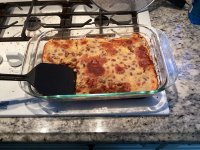Reading recipes for Pasta All'Amatriciana.
It would appear that I have all of the necessary ingredients to hand.
And yes, it does appear that I have all of the necessary ingredients to hand.
Pasta All'Amatriciana:
This is a deceptively easy recipe, is very tasty, and is one that uses very few ingredients, but, like all such recipes, it stands or falls on the quality of the ingredients used.
The first step is to prepare the guanciale, the pig's cheek.
Cut off the rind and the peppered side, and discard (although the rind can be retained and used to flavour stock, or soups).
Slice it, and then dice it, and put it into a large pan (I used a large copper sauté pan) where a small quantity of olive oil has been heating. The diced guanciale will become translucent and transparent, the fat will render (and will give a glorious flavour to the sauce) and blend with the olive oil.
When the diced guanciale has rendered - and you can stir it with a wooden spoon - the meat soft, the fat luscious and succulent, add a small glass of white wine to the pan, and stir, allowing the alcohol to burn off.
Meanwhile, prepare the tomatoes: These will come from a tin - San Marzano (an excellent Italian brand, for preference); Open the tin, and tip the contents into a bowl or dish, where you mash them and cut them up; season them (with sea salt, - some recipes insist that this is not necessary as the guanciale is already quite salty - but I am of the opinion that tomatoes, in common with potatoes and eggs, that tomatoes also require the addition of some salt - freshly ground black pepper, and a dash of sugar, I used organic brown sugar); this is then added to the sauté pan, where the chopped and sautéed guanciale awaits; let this cook, at a simmer, stir occasionally, for around twenty minutes.
While the sauce is simmering, prepare a green salad if you wish: Today, I used mixed leaves (organic), and prepared a dressing: Olive oil, red wine vinegar, sea salt, freshly ground black pepper, locally sourced organic runny honey (instead of sugar), French mustard.
I also grated some Pecorino Romano, to be served with the finished dish.
Water (rather than stock, the sauce will be sufficiently flavoursome, the pasta does not need the addition of being cooked in stock to enhance its flavour) is put to boil, with a little salt and olive oil added, and the pasta is then added once it has reached the boil. When almost ready, the pasta is drained, and added to the sauté pan, and a little of the pasta cooking water is retained, should a little more liquid need to be added to the sauce.
And this is when dinner is served.





